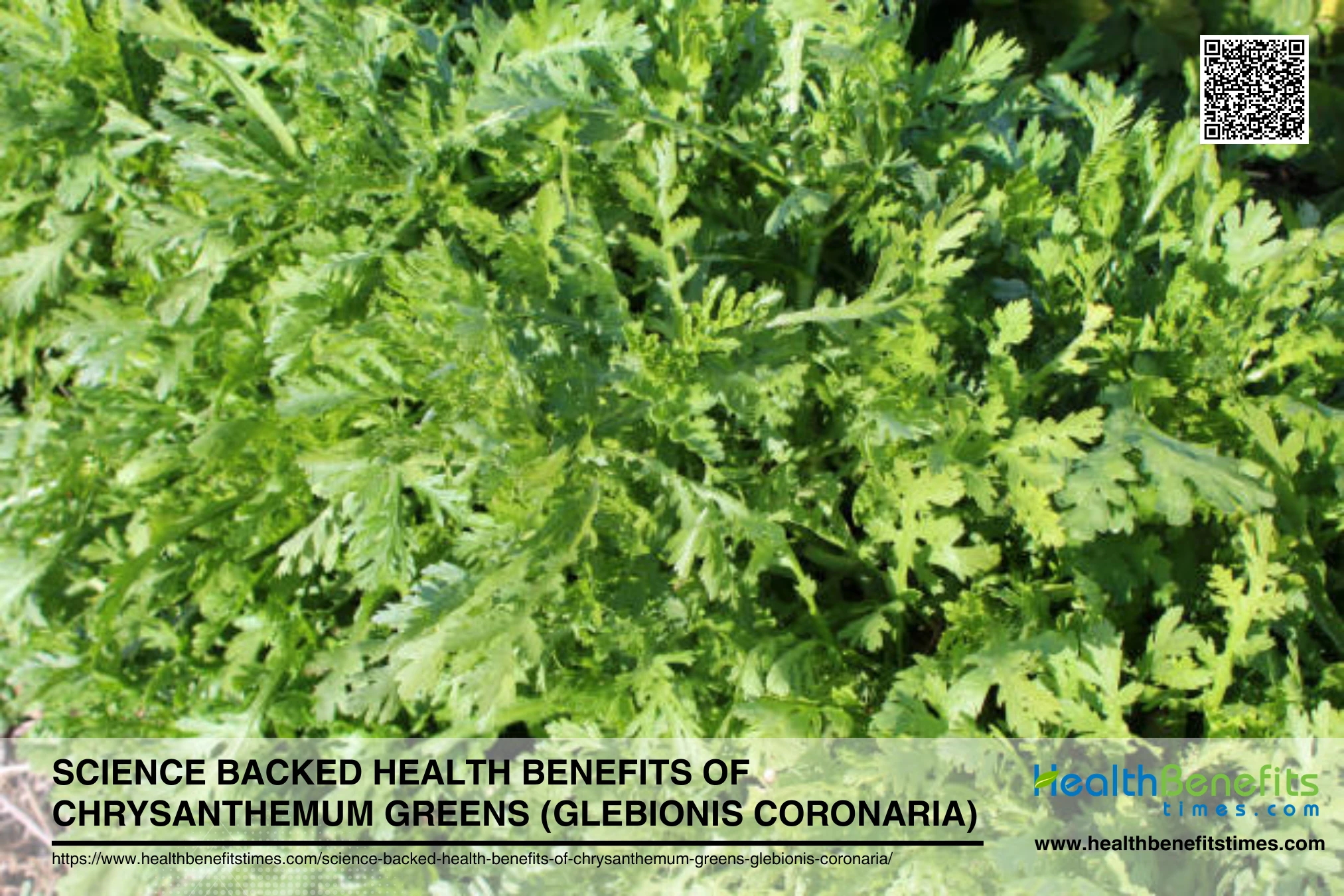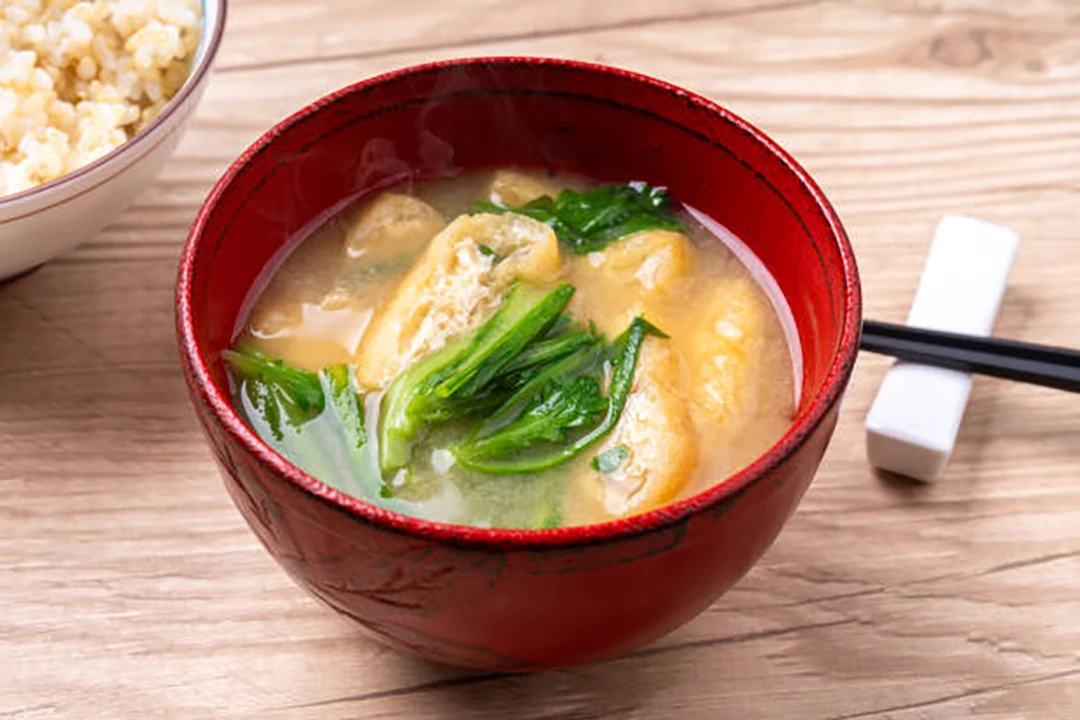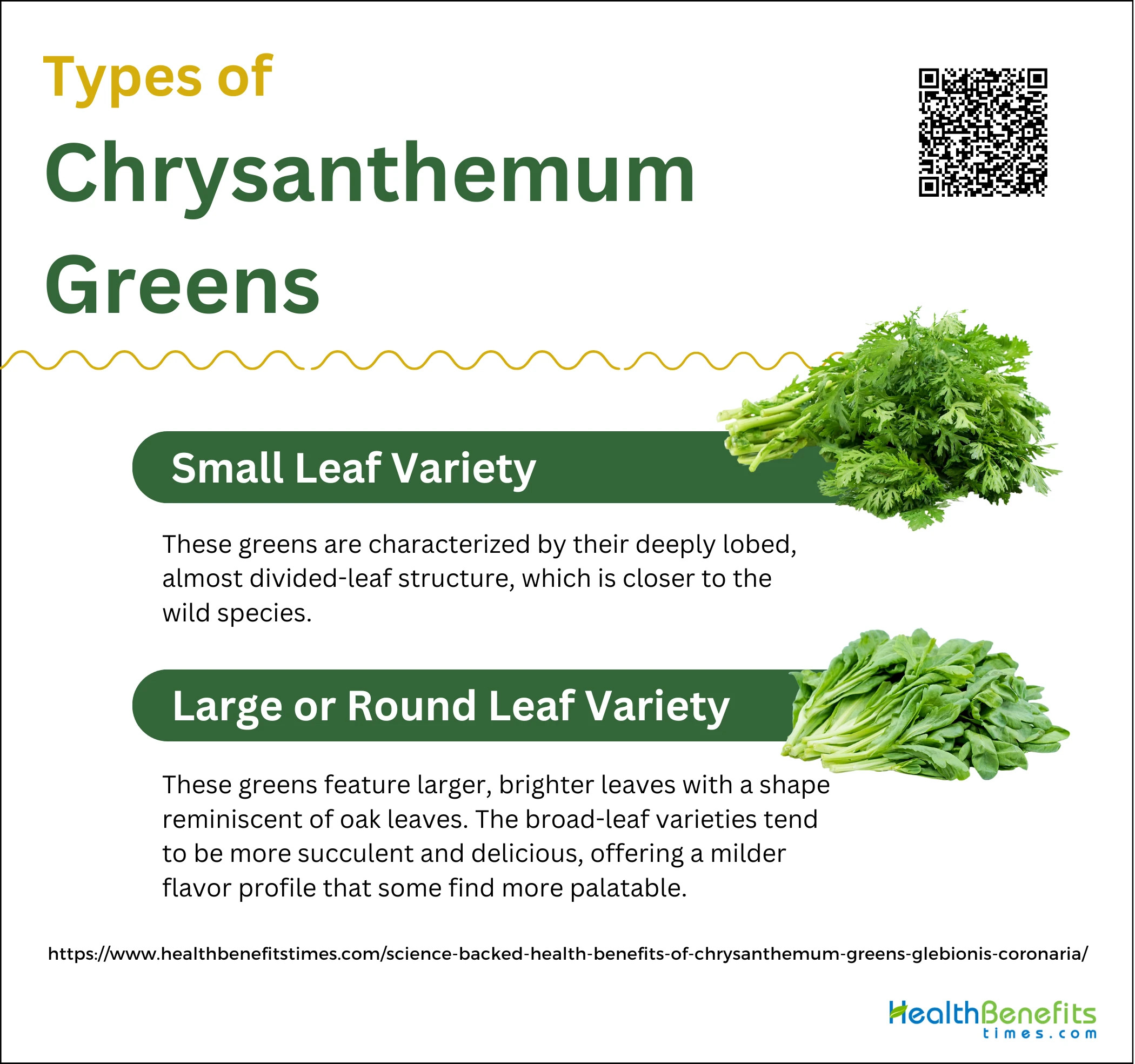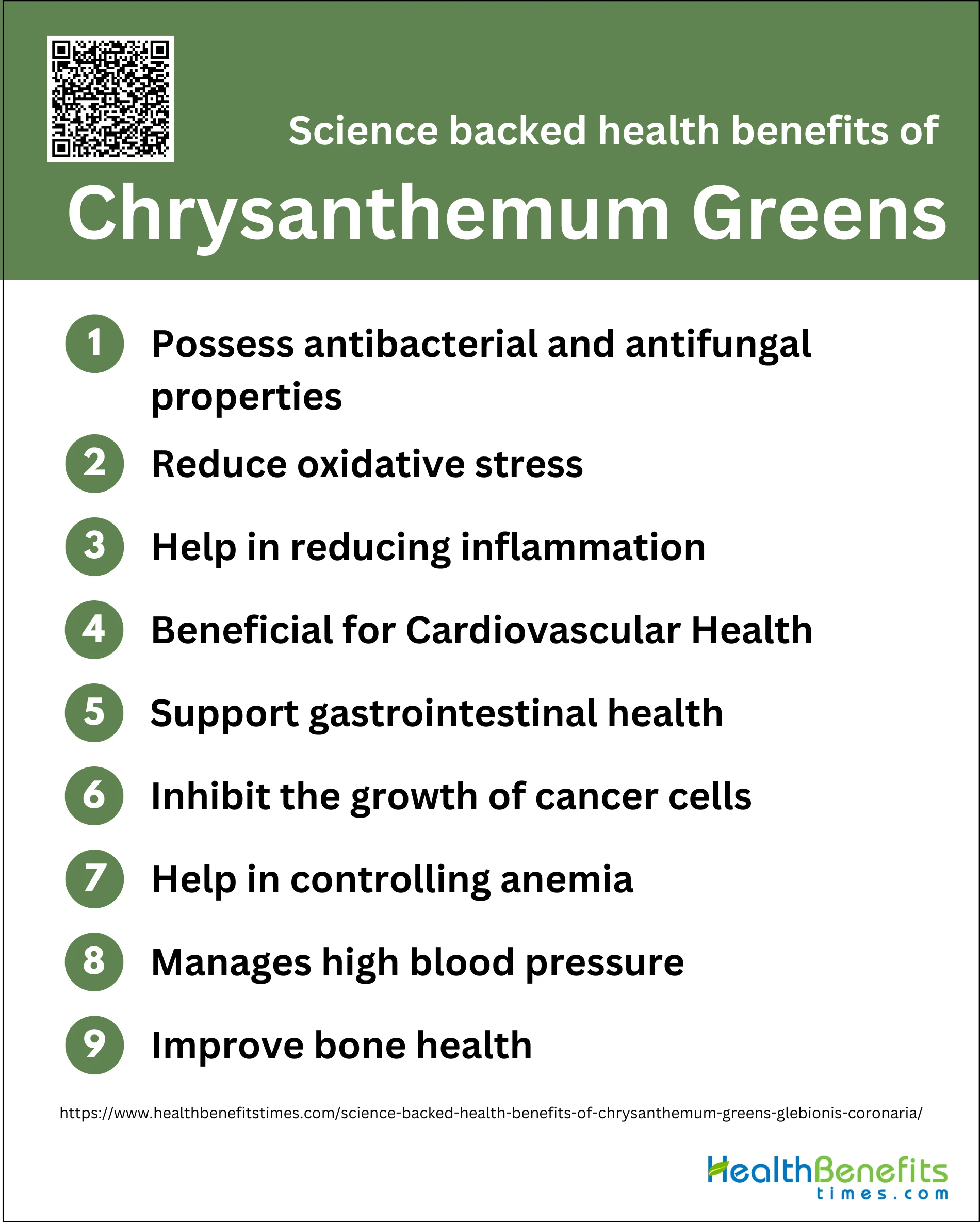- Chrysanthemum greens are nutritious, rich in vitamins, minerals, and antioxidants.
- Chrysanthemum greens are nutrient-dense, with antibacterial, antioxidant, and anti-inflammatory benefits.
- Chrysanthemum greens improve cardiovascular health, support digestion, and fight cancer.
- Chrysanthemum greens aid anemia through iron and vitamin C content.
- Add chrysanthemum greens to salads, soups, smoothies, and omelets.
- Chrysanthemum greens may cause allergies, photosensitivity, hypotension, or skin irritation.
 Chrysanthemum greens, scientifically known as Glebionis coronaria, are not just a colorful addition to gardens but also a nutritional powerhouse with numerous health benefits. This edible plant, often overlooked in Western cuisine, has been a staple in Asian diets for centuries. Recent scientific studies have begun to uncover the impressive array of nutrients and bioactive compounds present in chrysanthemum greens, revealing their potential to promote overall health and well-being. From boosting immunity to supporting bone health, these leafy greens offer a range of science-backed benefits that make them a valuable addition to any diet.
Chrysanthemum greens, scientifically known as Glebionis coronaria, are not just a colorful addition to gardens but also a nutritional powerhouse with numerous health benefits. This edible plant, often overlooked in Western cuisine, has been a staple in Asian diets for centuries. Recent scientific studies have begun to uncover the impressive array of nutrients and bioactive compounds present in chrysanthemum greens, revealing their potential to promote overall health and well-being. From boosting immunity to supporting bone health, these leafy greens offer a range of science-backed benefits that make them a valuable addition to any diet.
What is Chrysanthemum Greens ?
Chrysanthemum Greens is a versatile plant belonging to the Asteraceae family. Commonly referred to as garland chrysanthemum or crown daisy, it is valued for its culinary, medicinal, and ornamental uses. This hardy annual plant is native to the Mediterranean region but has been widely naturalized and cultivated in various parts of the world, including Central Polissya of Ukraine. Glebionis coronaria is known for its distinctive aroma, attributed to the presence of monoterpenoids such as 8-oxocitronellyl enol and isopiperitenone, which are highly expressed in its leaves and stems. The plant is rich in essential nutrients and bioactive compounds, including vitamins, carotenoids, flavonoids, and various macro- and microelements, making it a valuable source of biologically active substances for human health. It has been traditionally used in folk medicine to treat various ailments and is also a popular ingredient in Asian cuisine, where its young leaves and flowers are consumed as vegetables or used to garnish dishes. Additionally, Glebionis coronaria has shown potential in pharmaceutical applications due to its antioxidant, anti-inflammatory, and antimicrobial properties.
Nutritional Profile of Chrysanthemum Greens
Chrysanthemum greens are a nutritional powerhouse, offering a diverse array of essential nutrients that contribute to overall health and well-being. These leafy greens are low in calories but high in fiber, making them an excellent choice for those looking to maintain a healthy weight while supporting digestive health. The nutrient density of chrysanthemum greens is remarkable, with a single serving providing a significant percentage of the recommended daily intake for several key vitamins and minerals. This impressive nutritional profile has caught the attention of researchers and health enthusiasts alike, leading to increased interest in incorporating these greens into modern diets for their potential health benefits.
Rich in Vitamins (A, C, K)
Chrysanthemum greens are particularly notable for their high vitamin content, especially vitamins A, C, and K. Vitamin A, present in the form of beta-carotene, is crucial for maintaining healthy vision, supporting immune function, and promoting skin health. A single serving of chrysanthemum greens can provide a substantial portion of the daily recommended intake of this essential nutrient. Vitamin C, a powerful antioxidant, is abundant in these greens and plays a vital role in collagen synthesis, immune support, and protection against oxidative stress. Vitamin K, which is essential for blood clotting and bone health, is found in significant quantities in chrysanthemum greens. This combination of vitamins makes these greens a valuable addition to any diet, supporting overall health and potentially reducing the risk of various chronic diseases.
High in minerals (Calcium, Magnesium, Potassium)
Chrysanthemum greens are an excellent source of essential minerals, particularly calcium, magnesium, and potassium. Calcium, crucial for bone health and muscle function, is present in substantial amounts in these greens, making them a valuable alternative to dairy products for those seeking plant-based calcium sources. Magnesium, which plays a role in over 300 enzymatic reactions in the body, is also found in high concentrations in chrysanthemum greens. This mineral is essential for energy production, muscle and nerve function, and the regulation of blood pressure. Potassium, another vital mineral abundant in these greens, is crucial for maintaining proper heart function, regulating blood pressure, and supporting muscle contractions. The rich mineral content of chrysanthemum greens contributes significantly to their overall health benefits and makes them a valuable addition to a balanced diet.
Antioxidant Properties
Chrysanthemum greens are rich in antioxidants, including flavonoids and carotenoids, which help protect the body against oxidative stress and inflammation. While specific quantities are not provided in the search results, these antioxidants contribute to the overall health benefits of the greens. The high vitamin A content (560 mcg per 100g) is primarily in the form of beta-carotene, a powerful antioxidant. These antioxidants play a crucial role in neutralizing harmful free radicals in the body, potentially reducing the risk of chronic diseases and supporting overall health.
Low in Calories, High in Fiber
Chrysanthemum greens are an excellent choice for those looking to maintain a healthy weight while ensuring adequate nutrient intake. They are remarkably low in calories, with only 24 calories per 100g serving. Despite their low calorie content, these greens are high in dietary fiber, providing 3g per 100g serving, which accounts for 11-12% of the daily value. This combination of low calories and high fiber content makes chrysanthemum greens a satisfying and nutritious addition to meals, supporting digestive health and potentially aiding in weight management.
Types of Chrysanthemum Greens
Based on the search results, I can provide information on two main varieties of Chrysanthemum Greens. Here are individual paragraphs on each:
1. Small Leaf Variety
The small leaf variety of Chrysanthemum greens is the most common type found in markets and gardens. These greens are characterized by their deeply lobed, almost divided-leaf structure, which is closer to the wild species. The leaves are serrated, deeply incised, and somewhat fern-like in appearance, typically dark green in color. This variety tends to be easier to grow and more resilient, though it generally produces a lower yield compared to its broad-leaf counterpart. The small leaf variety is known for its more pungent and intense flavor, making it a popular choice in many Asian cuisines, particularly in soups, stews, and stir-fries. It’s often the variety you’ll encounter in Asian markets or CSA boxes, and it tends to have a moderate shelf life in the refrigerator.
2. Large or Round Leaf Variety
The large or round leaf variety of Chrysanthemum greens, also known as the broad-leaf type, is an older Chinese variety that offers a different set of characteristics compared to its small-leaf counterpart. These greens feature larger, brighter leaves with a shape reminiscent of oak leaves. The broad-leaf varieties tend to be more succulent and delicious, offering a milder flavor profile that some find more palatable. While they require more attention during cultivation and may be slightly more challenging to grow, they typically provide a higher yield of edible greens. This variety is prized for its tender texture and is often used in salads and other dishes where a less intense flavor is desired. The large leaf variety is less commonly found in markets but is a favorite among home gardeners who appreciate its unique appearance and versatile culinary applications.
Science backed health benefits of Chrysanthemum Greens
Chrysanthemum greens are more than just a vibrant addition to your garden or plate. These nutrient-packed leafy greens have been a staple in Asian cuisine for centuries, and modern science is now uncovering their impressive array of health benefits. From boosting immunity to supporting heart health, chrysanthemum greens offer a wide range of advantages that make them a valuable addition to any diet. In this article, we’ll explore the science-backed health benefits of chrysanthemum greens, revealing why these often-overlooked vegetables deserve a prominent place in your meal planning. Get ready to discover how these humble greens can contribute to your overall well-being in ways you might never have imagined.
1. Possess antibacterial and antifungal properties
Chrysanthemum greens possess notable antibacterial and antifungal properties, making them a valuable addition to both culinary and medicinal applications. These greens contain various bioactive compounds, including essential oils and extracts, which exhibit significant antimicrobial activity. These properties are attributed to the presence of tannins, flavonoids, and other phytochemicals that can inhibit the growth of harmful bacteria and fungi. Studies have demonstrated that Glebionis coronaria can effectively combat a range of pathogens, potentially reducing the risk of infections and contributing to overall health. This antimicrobial potential underscores the therapeutic value of chrysanthemum greens, supporting their traditional use in herbal medicine and highlighting their benefits in modern health practices.
What Research Says?
- Essential oils from the flowerheads of Glebionis coronaria exhibit antifungal properties, inhibiting the growth of various agricultural pathogens. The main active compounds include camphor, alpha-pinene, beta-pinene, and lyratyl acetate.
- A novel antifungal protein, chrysancorin, isolated from the seeds of Glebionis coronaria, shows activity against specific fungi such as Botrytis cinerea and Mycosphaerella arachidicola, but not against others like Rhizoctonia solani.
- Essential oils from Glebionis coronaria have demonstrated antibacterial activity, particularly against Gram-positive bacteria such as Staphylococcus aureus. The ethanolic extract also shows antimicrobial activity against Gram-positive bacteria.
2. Reduce oxidative stress
Chrysanthemum greens are highly effective in reducing oxidative stress due to their rich content of antioxidants. These leafy greens contain significant amounts of flavonoids and carotenoids, which are known for their ability to neutralize free radicals in the body. Free radicals are unstable molecules that can cause cellular damage, leading to chronic diseases and aging. By scavenging these harmful molecules, the antioxidants in chrysanthemum greens help protect cells from oxidative damage. This protective effect supports overall health and may reduce the risk of conditions such as heart disease, cancer, and neurodegenerative disorders. Regular consumption of chrysanthemum greens can thus contribute to maintaining a balanced oxidative state in the body, promoting long-term health and well-being.
What Research Says?
- Chrysanthemum greens exhibit high activity of antioxidative enzymes such as superoxide dismutase (SOD), catalase (CAT), and glutathione peroxidase (GSH-Px), which contribute to their ability to mitigate oxidative stress.
- The consumption of chrysanthemum extracts has been shown to reduce oxidative stress markers such as malondialdehyde and improve the ratio of reduced glutathione to oxidized glutathione, indicating a reduction in oxidative damage.
- Chrysanthemum extracts can protect cells from oxidative damage by inhibiting cell death, relieving cell cycle arrest, and preventing non-apoptotic cell damage. This is achieved through the upregulation of antioxidative enzymes and modulation of metabolic pathways related to antioxidation.
3. Help in reducing inflammation

Chrysanthemum greens have demonstrated significant anti-inflammatory properties, making them a valuable natural remedy for various inflammatory conditions. The plant contains bioactive compounds, including flavonoids and carotenoids, which contribute to its anti-inflammatory effects. Extracts from chrysanthemum greens can inhibit the production of pro-inflammatory cytokines such as TNF-α and reduce levels of inflammatory markers in the body. This anti-inflammatory action extends to systemic low-grade inflammation, with studies indicating that chrysanthemum extracts can decrease serum levels of inflammatory markers by over 60%. Additionally, the plant’s ability to modulate gut microbiota and increase short-chain fatty acid production further supports its anti-inflammatory effects. These properties make chrysanthemum greens a promising natural option for managing chronic inflammatory diseases and promoting overall health.
What Research Says?
- Glebionis coronaria contains various bioactive compounds, including tannins, vitamins, and beta-carotene, which contribute to its anti-inflammatory properties.
- The plant’s extract has been shown to inhibit homocysteine-induced vascular inflammation in vascular smooth muscle cells, reducing the expression of inflammatory markers and reactive oxygen species.
- The anti-inflammatory effects of Glebionis coronaria are partly due to its ability to modulate gut microbiota and increase short-chain fatty acids (SCFAs), which help reduce systemic low-grade inflammation.
- The combination of Chrysanthemum morifolium and wolfberry has been found to reduce LPS-induced nitric oxide production and inhibit the expression of inflammatory cytokines such as TNF-α, IL-1β, and IL-6, indicating a synergistic anti-inflammatory effect.
4. Beneficial for Cardiovascular Health
Chrysanthemum greens offer significant benefits for cardiovascular health, primarily due to their rich nutrient profile and bioactive compounds. These greens are abundant in flavonoids and chlorogenic acid, both of which have been shown to lower blood pressure and reduce the risk of heart disease. Flavonoids, in particular, help improve endothelial function and reduce arterial stiffness, which are critical factors in maintaining healthy blood vessels and preventing cardiovascular issues. Additionally, the high potassium content in chrysanthemum greens supports heart health by helping to regulate blood pressure and counteract the effects of sodium. Regular consumption of these greens can thus contribute to a healthier cardiovascular system, reducing the likelihood of hypertension and other heart-related conditions.
What Research Says?
- Studies have shown that Glebionis coronaria has anti-inflammatory and anti-cholesterol properties, which are crucial for maintaining cardiovascular health. These effects are attributed to its rich phytochemical profile.
- The plant is rich in essential minerals such as potassium (K), sodium (Na), calcium (Ca), phosphorus (P), zinc (Zn), iron (Fe), copper (Cu), manganese (Mn), and iodine (I). These minerals play a significant role in cardiovascular function and overall health.
5. Support gastrointestinal health

Chrysanthemum greens deliver significant benefits for gastrointestinal health, primarily due to their high fiber content and unique phytochemical composition. These leafy greens are an excellent source of dietary fiber, providing about 1.53 grams per cup, which aids in promoting regular bowel movements and preventing constipation. The fiber in chrysanthemum greens also acts as a prebiotic, nourishing beneficial gut bacteria and supporting a healthy microbiome. Additionally, these greens contain compounds that may help reduce inflammation in the digestive tract and protect against gastrointestinal disorders. Their low calorie content and nutrient density make them an ideal food for maintaining a healthy weight, which is crucial for overall digestive health.
What Research Says?
- Chrysanthemum greens contain high levels of essential micro- and macroelements (e.g., K, Na, Ca, P, Zn, Fe, Cu, Mn, J) and biologically active compounds such as anthraquinones (emodin, chrysophanol), flavonoids (quercetin, rutin), carotenoids, and ascorbic acid. These elements and compounds are known to have positive therapeutic effects on the gastrointestinal tract.
- The leaves of chrysanthemum greens have been used in traditional medicine as a tonic for the liver, blood, and intestines, and to control anemia and high blood pressure. This suggests a historical recognition of its benefits for gastrointestinal health.
6. Inhibit the growth of cancer cells
Chrysanthemum greens have shown promising potential in inhibiting the growth of cancer cells, thanks to their rich phytochemical composition. These compounds work by inducing apoptosis (programmed cell death) in cancer cells and inhibiting their proliferation. Extracts from Glebionis coronaria can effectively target and reduce the viability of cancerous cells, thereby slowing down tumor growth. The plant’s antioxidant properties further enhance its anticancer potential by protecting healthy cells from oxidative damage and reducing inflammation, which is often associated with cancer progression.
What Research Says?
- Chrysanthemum indicum ethanolic extract (CIE) significantly suppresses the proliferation and invasion of hepatocellular carcinoma (HCC) cells by decreasing MMP-2 and MMP-9 expression and increasing TIMP-1 and TIMP-2 expression, thereby restoring their balance.
- Chrysanthemum indicum Linné extracts (CILE) inhibit the growth of HCC cells by attenuating the mitogenic effect of isoproterenol (ISO) through the inhibition of MAPK/ERK1/2 activation via beta2-AR.
- Glebionis coronaria contains various bioactive compounds such as tannins, vitamins, beta-carotene, and proteins, which contribute to its medicinal properties, including potential anticancer activities.
7. Help in controlling anemia

Chrysanthemum greens can play a beneficial role in controlling anemia due to their rich nutrient profile, particularly their iron content. Anemia, often caused by iron deficiency, can lead to fatigue, weakness, and other health issues. Chrysanthemum greens provide a good source of iron, which is essential for the production of hemoglobin, the protein in red blood cells that carries oxygen throughout the body. Additionally, these greens are high in vitamin C, which enhances the absorption of iron from plant-based sources. The combination of iron and vitamin C in chrysanthemum greens makes them an effective dietary option for preventing and managing anemia. Regular consumption of these greens can help maintain healthy iron levels, support red blood cell production, and improve overall energy and vitality.
What Research Says?
- Chrysanthemum extracts, when combined with red spinach, contain high levels of flavonoids and phenols, which enhance iron absorption in the intestine and exhibit strong antioxidant activity, potentially serving as an anti-anemia treatment.
- Chrysanthemum extracts, when combined with red spinach, contain high levels of flavonoids and phenols, which enhance iron absorption in the intestine and exhibit strong antioxidant activity, potentially serving as an anti-anemia treatment.
- Chrysanthemum extracts possess significant antioxidant properties, which can improve overall antioxidant status in the body. This enhancement in antioxidant status can indirectly support the management of anemia by reducing oxidative stress, which is often associated with anemia.
8. Manages high blood pressure
Chrysanthemum greens are highly effective in managing high blood pressure, making them a valuable addition to a heart-healthy diet. These greens are rich in potassium, a mineral known for its ability to help regulate blood pressure by counteracting the effects of sodium in the body and promoting vasodilation, which widens blood vessels and improves blood flow. Additionally, chrysanthemum greens contain various bioactive compounds, including flavonoids and chlorogenic acid, which have been shown to exhibit antihypertensive properties. These compounds help relax blood vessels and reduce arterial stiffness, thereby lowering blood pressure.
What Research Says?
- A study found that dietary supplementation with leafy green vegetables, including those high in inorganic nitrate, did not significantly decrease ambulatory systolic blood pressure in subjects with elevated blood pressure.
- Chrysanthemum greens have been traditionally used in folk medicine to control high blood pressure, among other health benefits.
9. Improve bone health

Chrysanthemum greens can contribute significantly to improving bone health due to their rich nutrient profile. These greens are an excellent source of calcium, providing about 9% of the daily value per 100g serving, which is essential for maintaining strong bones and teeth. Additionally, they contain vitamin K, crucial for proper calcium absorption and bone metabolism. The high magnesium content in chrysanthemum greens (30-32 mg per 100g) also plays a vital role in bone health by contributing to bone mineral density and reducing the risk of osteoporosis. Furthermore, the antioxidants present in these greens, such as flavonoids and carotenoids, help protect bone cells from oxidative stress, which can lead to bone loss over time. Regular consumption of chrysanthemum greens as part of a balanced diet can thus support overall bone health, potentially reducing the risk of fractures and age-related bone diseases.
What Research Says?
- Chrysanthemum coronarium L. (CC) extracts stimulate osteoblast differentiation and mineralized bone formation by increasing the expression of bone formation markers such as alkaline phosphatase and osteoprotegerin.
- Chrysanthemum indicum extract (CIE) enhances primary osteoblast differentiation by upregulating alkaline phosphatase and increasing extracellular calcium concentrations.
Nutritional Comparison with Spinach, Kale, and Others
When comparing chrysanthemum greens to other popular leafy greens like spinach and kale, several nutritional differences stand out. Chrysanthemum greens are particularly rich in vitamin A, providing a significant amount of beta-carotene, which is higher than that found in spinach. While kale is known for its high vitamin K content, chrysanthemum greens also offer substantial amounts of this essential nutrient, supporting blood clotting and bone health. In terms of minerals, chrysanthemum greens contain comparable levels of calcium and magnesium to both spinach and kale, making them a valuable source of these bone-supporting minerals. Additionally, chrysanthemum greens are rich in potassium, which is crucial for heart health and blood pressure regulation, similar to spinach. However, chrysanthemum greens have a unique flavor profile and different bioactive compounds that set them apart from these other leafy greens, offering a diverse array of health benefits.
Unique Benefits of Chrysanthemum Greens
Chrysanthemum greens offer several unique benefits that distinguish them from other leafy greens. One of the standout features of chrysanthemum greens is their potent antimicrobial properties, which include antibacterial and antifungal effects, thanks to their rich content of bioactive compounds such as tannins and flavonoids. Additionally, these greens are known for their ability to reduce oxidative stress and inflammation, which can help protect against chronic diseases and support overall health. Chrysanthemum greens also have specific compounds that may inhibit the growth of cancer cells, making them a valuable addition to a cancer-preventive diet. Moreover, their high fiber content supports gastrointestinal health by promoting regular bowel movements and nourishing beneficial gut bacteria. These unique benefits, combined with their rich nutrient profile, make chrysanthemum greens a versatile and health-promoting addition to any diet.
How to Incorporate Chrysanthemum Greens in Your Diet
Incorporating chrysanthemum greens into your diet can be both simple and delicious with a few easy recipes and preparation tips. Start by thoroughly washing the greens to remove any dirt or debris. For a quick and nutritious side dish, sauté the greens with garlic and a splash of soy sauce. Another easy option is to add them to soups or broths; simply stir them in during the last few minutes of cooking to preserve their texture and nutrients. For a fresh and vibrant salad, use younger, tender leaves mixed with other greens, and dress with a light vinaigrette. You can also blend chrysanthemum greens into smoothies for a nutrient boost or incorporate them into omelets and frittatas. These versatile greens can be enjoyed in a variety of dishes, making it easy to add them to your daily meals.

Best Ways to Preserve Nutrients
To maximize the nutritional benefits of chrysanthemum greens, it’s important to use cooking methods that preserve their valuable vitamins and minerals. Light cooking methods, such as steaming or blanching, are ideal for retaining nutrients. When blanching, immerse the greens in boiling water for just 30 seconds to 1 minute, then quickly transfer them to an ice bath to halt the cooking process. This technique helps maintain their vibrant color and crisp texture while preserving their nutrient content. Avoid overcooking, as prolonged exposure to heat can degrade sensitive vitamins like vitamin C and folate. If you prefer raw preparations, using the greens in salads or as garnishes is an excellent way to retain all their nutritional benefits. Storing the greens properly, in a cool, dark place or in the refrigerator, also helps maintain their freshness and nutrient levels.
Creative Meal Ideas
Chrysanthemum greens can be a delightful addition to a variety of creative meals, adding both flavor and nutritional value. For a unique twist on traditional pesto, blend chrysanthemum greens with garlic, nuts, Parmesan cheese, and olive oil to create a vibrant, green sauce perfect for pasta or as a spread on sandwiches. Another idea is to incorporate these greens into a savory pancake or fritter batter, combining them with ingredients like scallions, grated carrots, and a touch of soy sauce for a tasty appetizer or side dish. For a refreshing and nutritious smoothie, blend chrysanthemum greens with fruits like pineapple, banana, and a splash of coconut water. You can also use the greens as a flavorful addition to grain bowls, pairing them with quinoa, roasted vegetables, and a tangy tahini dressing. These creative meal ideas showcase the versatility of chrysanthemum greens and make it easy to enjoy their health benefits in a variety of delicious ways.
Side effects of consuming Chrysanthemum Greens
While chrysanthemum greens are celebrated for their nutritional benefits and culinary versatility, it’s important to be aware of potential side effects that may occur when consuming this leafy vegetable. As with any food, moderation is key, and individual reactions can vary. In this article, we’ll explore the possible side effects of consuming chrysanthemum greens, ranging from mild allergic reactions to more serious health concerns. Understanding these potential risks can help you make informed decisions about incorporating chrysanthemum greens into your diet and ensure you’re enjoying them safely. Whether you’re a long-time fan of these greens or considering trying them for the first time, this comprehensive guide will provide valuable insights into the lesser-known aspects of this popular Asian vegetable.
Allergic Reactions
Chrysanthemum greens can cause allergic reactions in some individuals, particularly those who are sensitive to plants in the Asteraceae/Compositae family, which includes ragweed, marigolds, and daisies. Symptoms of an allergic reaction may include skin rash, eczema, hay fever, asthma, and inflammation of the sinuses. If you experience any of these symptoms after consuming or coming into contact with chrysanthemum greens, it is important to consult a healthcare provider to confirm the allergy and discuss alternative dietary options.
Photosensitivity
One of the notable side effects of consuming chrysanthemum greens is photosensitivity, where the skin becomes extra sensitive to sunlight. This condition can lead to sunburns and other skin irritations when exposed to ultraviolet light. The photosensitivity is attributed to certain chemicals in the plant, such as alantolactone. To mitigate this risk, it is advisable to wear sunblock and protective clothing when spending time outdoors, especially for individuals with light skin.
Hypotension
Chrysanthemum greens have been shown to lower blood pressure, which can be beneficial for individuals with hypertension. However, this effect can pose risks for people who are already taking blood pressure medications or sedatives, as it may enhance the effects of these drugs and lead to dangerously low blood pressure levels. Therefore, it is crucial for individuals on such medications to consult their healthcare provider before adding chrysanthemum greens to their diet.
Skin Irritation
Handling or consuming chrysanthemum greens can lead to skin irritation in some people. This can manifest as contact dermatitis, characterized by red, inflamed patches of skin, or as photosensitivity, where exposure to sunlight causes skin irritation. Individuals who are sensitive to the chemicals in chrysanthemum greens should wear gloves when handling the plant and avoid prolonged exposure to sunlight after consumption.
Drug Interactions
Chrysanthemum greens may interact with various medications, herbs, and supplements. For instance, they can enhance the effects of pain-numbing drugs, antibacterial agents, anti-cancer medications, and anti-inflammatory supplements. This can potentially lead to adverse effects or reduce the efficacy of these treatments. People taking medications for conditions such as diabetes, gout, HIV, or herpes should consult their healthcare provider before consuming chrysanthemum greens to avoid any harmful interactions.
Poisoning
Chrysanthemum greens contain pyrethrins, chemicals that can be toxic if ingested in large quantities or over long periods. Pyrethrin poisoning can affect the nervous system and cause symptoms such as eye damage, asthma, and inflammation. It is important to avoid consuming large doses of chrysanthemum greens and to be cautious of products containing pyrethrins to prevent poisoning.
Pregnancy and Breastfeeding
There is insufficient reliable information regarding the safety of consuming chrysanthemum greens during pregnancy and breastfeeding. Due to the potential risks and lack of comprehensive studies, it is recommended that pregnant and breastfeeding women avoid consuming chrysanthemum greens to ensure their safety and that of their child.
Conclusion
In conclusion, chrysanthemum greens offer a wealth of health benefits, from their rich nutritional profile to their potential to combat various ailments. These versatile greens are packed with essential vitamins, minerals, and antioxidants, making them a valuable addition to a balanced diet. Their ability to reduce oxidative stress, fight inflammation, support cardiovascular health, and potentially inhibit cancer cell growth underscores their importance in promoting overall well-being. While chrysanthemum greens present numerous advantages, it’s crucial to be aware of potential side effects and interactions, especially for individuals with specific health conditions or those taking certain medications. As with any dietary change, moderation and consultation with a healthcare professional are advised. By incorporating chrysanthemum greens into your meals creatively and mindfully, you can harness their unique flavor and impressive health benefits to enhance your nutritional intake and support your body’s natural functions.
ADDITIONAL RESOURCES
Here’s a list of US organizations focused on research related to vegetables, including their descriptions and URLs:
1. Horticultural Research Institute (HRI)
The HRI supports research aimed at improving the horticultural industry, including vegetable production, through grants and partnerships.
2. National Vegetable Research Initiative (NVRI)
The NVRI funds and supports research projects aimed at advancing vegetable production technologies and improving crop yields.
3. The American Society for Horticultural Science (ASHS)
ASHS promotes scientific research in horticulture, including vegetables, through publications, conferences, and awards.
Recommendations for books on Chrysanthemum greens
Books specifically focused on research about chrysanthemum greens can be a bit niche, but there are broader resources on medicinal plants and herbs that cover chrysanthemum. Here are some recommendations that include information on chrysanthemum greens:
1. “The Encyclopedia of Medicinal Plants: A Practical Reference Guide to over 550 Key Herbs and Their Medicinal Uses” by Andrew Chevallier
This comprehensive guide covers a wide range of medicinal plants, including chrysanthemum, with details on their uses and benefits.
2. “Herbs of the Garden, Kitchen, and Pharmacy” by Diane E. Kennedy
Offers insights into various herbs, including chrysanthemum, with a focus on their culinary and medicinal uses.
3. “The Complete Guide to Medicinal Herbs” by Amanda McQuade Crawford
Provides an overview of numerous medicinal herbs, including chrysanthemum, and their health benefits.
4. “Botanical Medicine for Women’s Health” by Tori Hudson
This book discusses various herbs used in women’s health, including chrysanthemum, focusing on their therapeutic benefits.
5. “Chinese Herbal Medicine: Materia Medica” by Dan Bensky and Andrew Gamble
An authoritative text on Chinese herbs, including chrysanthemum, providing detailed information on their medicinal uses.
6. “The Herbal Medicine-Maker’s Handbook: A Home Manual” by James Green
This practical guide includes recipes and techniques for making herbal remedies, including those using chrysanthemum.
7. “Medicinal Herbs: A Beginner’s Guide” by Rosemary Gladstar
Provides a beginner-friendly introduction to various medicinal herbs, including chrysanthemum, with practical advice on their use.
FAQS
- What are chrysanthemum greens?
Chrysanthemum greens, also known as Glebionis coronaria, shungiku, or garland chrysanthemum, are leafy vegetables commonly used in East Asian cuisine. They have a mildly grassy and herbaceous flavor and are rich in nutrients like vitamins A, C, and K, potassium, calcium, and iron.
- What are the nutritional benefits of chrysanthemum greens?
Chrysanthemum greens are packed with essential nutrients. They are an excellent source of vitamins A, C, and K, and contain significant amounts of potassium, calcium, iron, and dietary fiber. These nutrients contribute to overall health, including maintaining skin and bone health, supporting immune function, and aiding digestion.
- How do chrysanthemum greens support cardiovascular health?
Chrysanthemum greens contain flavonoids and chlorogenic acid, which have been shown to help lower blood pressure and reduce the risk of heart disease. These compounds help maintain cardiovascular health by improving blood flow and reducing oxidative stress on the heart.
- Do chrysanthemum greens have antioxidant properties?
Yes, chrysanthemum greens are rich in antioxidants such as carotenoids and flavonoids. These antioxidants help neutralize free radicals in the body, reducing oxidative stress and potentially lowering the risk of chronic diseases like cancer and heart disease.
- Can chrysanthemum greens aid in weight management?
Chrysanthemum greens are low in calories but high in nutrients and dietary fiber, which can help promote a feeling of fullness and reduce overall calorie intake. This makes them a beneficial addition to a weight management diet.
- What are the digestive benefits of chrysanthemum greens?
The dietary fiber in chrysanthemum greens supports healthy digestion by promoting regular bowel movements and preventing constipation. Additionally, the distinctive aroma of the greens may aid in better digestion and nutrient absorption.
- Are there any potential side effects of consuming chrysanthemum greens?
While chrysanthemum greens are generally safe to consume, some individuals may experience allergic reactions, especially those allergic to plants in the Asteraceae family (e.g., daisies, ragweed). Overconsumption may also lead to stomach upset due to their high fiber content.
- How can chrysanthemum greens benefit skin health?
Chrysanthemum greens contain antioxidants and anti-inflammatory properties that may protect the skin from damage caused by free radicals and reduce inflammation. This can help maintain healthy, youthful skin.
- Can chrysanthemum greens improve hair health?
The vitamins and minerals found in chrysanthemum greens, such as vitamin A and iron, can contribute to stronger hair follicles and promote hair growth, potentially improving overall hair health.
- How should chrysanthemum greens be prepared and consumed?
Chrysanthemum greens can be eaten raw in salads, blanched, or added to soups, stews, and stir-fries. It is recommended to avoid overcooking them to preserve their nutritional content and prevent the release of bitter flavors.



